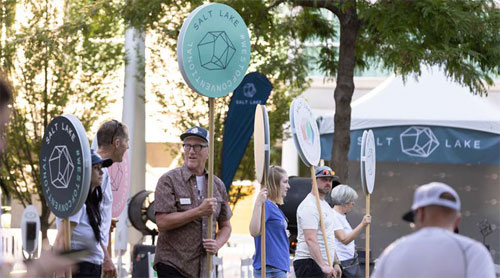By Brice Wallace
Southern Utah may have a monopoly on Utah’s national parks, but tourism industry representatives in Northern Utah say their region has plenty for tourists, either as a destination or as a great scenic path for visitors on their way from Salt Lake City to Yellowstone National Park.
Meeting in Logan recently for the Greater Cache Valley Economic Summit, speakers during a panel discussion said their agencies’ collaborations are making their tourism efforts stronger.
Joan Hammer, director of the Box Elder Visitors Bureau, said the region has variety, with Box Elder County being the premier birding destination in the western U.S., Cache Valley being the “Heart of the Arts,” and Bear Lake being “the Caribbean of the Rockies.”
“You think about all those things and you put them all together, and what a trip for someone to take!” she said at the event, sponsored by the Cache Valley Chamber of Commerce, World Trade Center Utah and Dominion Energy.
Julie Hollist-Terrill, director of the Cache Valley Visitors Bureau, quoted a Kem C. Garden Policy Institute study from 2019 indicating that tourism accounted for 1,720 direct jobs in Cache County and 487 indirect jobs. Visitors to the county that year spent a total of $187 million.
Tami Leonhardt, director of the Bear Lake Valley Convention & Visitors Bureau, also spoke about the region’s complementary attractions.
“Box Elder starts and then just kind of leads us all up to Bear Lake. … ” she said. “And this is really important, too, because a lot of people will get off at the [Salt Lake] airport, they’ll come down, they’re ready to go to Yellowstone, but, wait, you’ve got to see our place first.”
Hammer said collaboration has been in place for years, back when she and Hollist-Terrill worked with officials in Rich County, where Bear Lake straddles the Utah-Idaho border.
“We knew that, yeah, there’s a faster way to go to Yellowstone if you stay on I-15,” Hammer said, “but we figured out, you know, it’s really not that much faster and it definitely isn’t as cool as going through our area,”
That collaboration, under the name “Top of Utah,” worked for each agency.
“We could be petty and be competitive over who gets the people to stay overnight,” Hollist-Terrill said, “but instead we recognize that we all have really unique resources. If we come together and capture people in our region, then everyone benefits.”
“Julie’s right,” Hammer said. “We don’t argue over who gets the night’s stay or who gets the whatever, because we know that we each have something unique to offer and when we bring them all together, it’s something spectacular.”
Leonhardt said Bear Lake last year had “one of our busiest” years because people during the COVID-19 pandemic “felt safe being outside.” Hollist-Terrill added that “our outdoors are just being stampeded.”
As the agencies work to manage tourism opportunities and experiences, they also are working with others to ensure that tourism augments broader economic development possibilities.
“If my economic development office is bringing in some folks, if they’re trying to bring in businesses, we always participate in that, because we want a business to come in and feel the quality of life,” Hammer said. “’What is there to do? Why should my employees live here? Why should they recreate here?’”
She attributed Procter & Gamble’s decision to put a paper products manufacturing plant in Box Elder County partly to quality-of-life factors.
“We know that tourism matters [to companies]. Tourism is just that really sweet piece that makes people feel really good about wanting to be here. I will tell you, when we got Procter & Gamble, we got Procter & Gamble for a lot of reasons, but one of the biggest reasons we got Procter & Gamble was they loved our community, they loved what we were doing, they just wanted to be here and wanted to be a part of what we were.”
Keynote speaker Vicki Varela, managing director of tourism and film at the Governor’s Office of Economic Development, said that tourism and traditional economic development “play well together.”
“What does that mean for you?” she asked the crowd. “It means that we want to work more strategically with you than we ever have before. That we want to collaborate with tradition economic development more than we ever have before, recognizing that tourism is a welcome mat for other economic development.”
Her office, she said, recognizes that it is doing well promoting the region as a tourism economy, “but we could do more.” The office is in the beginning stages of creating a Northern Utah marketing strategy “to organize how you want your regional story to be told,” she said.
Opportunities abound in agritourism, arts and culture, and birding, she added. “We have the most remarkable birding probably anywhere in the United States, and there’s great opportunity to create tourism itineraries around that.”








